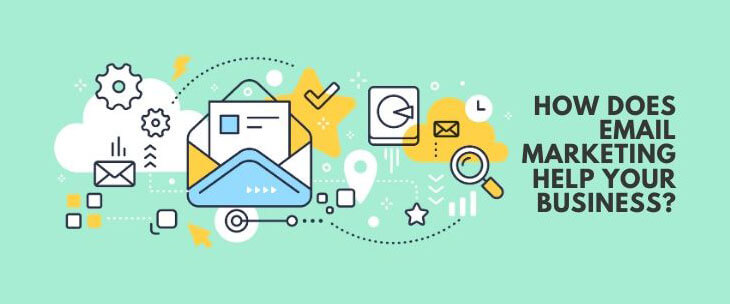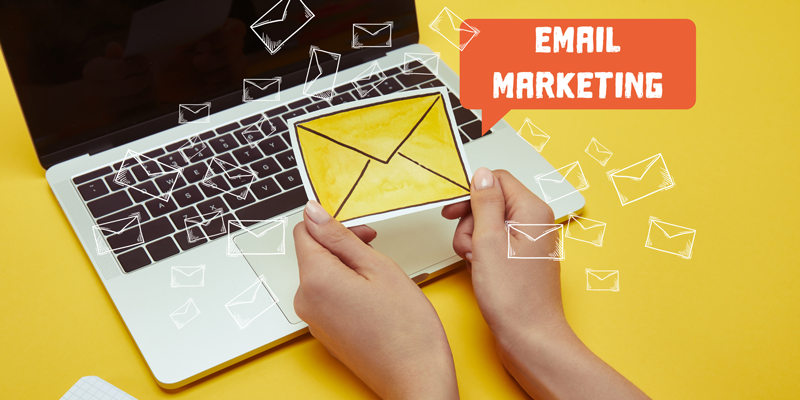Email marketing helps new businesses grow by reaching customers effectively. It offers direct communication and measurable results.
Starting a new business is not easy. You need to find people who might buy from you. You also need a way to talk to them. Email marketing is a great way to do this.
With email, you can send messages straight to people’s inbox. You can share news, special offers, or helpful tips. This makes people feel special and helps them trust your business.
Many new businesses have small budgets and few workers. Email marketing is cheap and easy to use. Even small businesses can do it. You can also see who opened your emails and what they clicked. This helps you learn what works best.
With a good plan, email marketing can help you grow faster.

Credit: www.logicalposition.com
Introduction To Email Marketing
Email marketing helps new businesses grow. It lets you talk directly to your audience. You can build trust and make more sales. In this part, we’ll look at what email marketing is and why it’s good for a new business.
What Is Email Marketing?
Email marketing means sending emails to people who may want your products or services. These emails might have offers, updates, or news. You want your readers to do something, like click a link or make a purchase. You can make emails feel personal by using their names and sharing things they care about.
Importance For New Businesses
A new business needs people to hear about it. If no one knows your business exists, it can’t grow. That’s why finding a simple and smart way to talk to people is so important.
Email marketing is one of the best ways to do this. It doesn’t cost a lot of money, and it really works. You can send messages straight to someone’s email. You can tell them who you are, what you offer, or share something helpful.
The best part? You can see how many people opened your email or clicked on a link. This helps you understand what people like. Maybe they clicked on a special offer or liked a helpful tip. You can use this to make your next email even better.
When you send emails often—like once a week or once a month—people start to remember you. They begin to trust you. And when they need something, they’ll think of your business first. This is how email marketing helps you grow, one message at a time.
Building An Email List
Your email list is like a list of friends who want to hear from you. These people gave you their email because they are interested in what you do. For a new business, this list is super valuable.
With email marketing, you can use this list to stay in touch. You can share news, special offers, new products, or simple updates. And the best part? You don’t have to wait for people to find you—you can reach out to them anytime.
Imagine being able to send one message and have many people read it. That’s the power of your email list. It helps you build a connection, grow trust, and slowly turn people into loyal customers.
Gathering Subscribers
Start by thinking about where your customers hang out online. Are they on Instagram? Do they visit certain websites? Meet them where they are.
Offer something valuable in exchange for their email. A discount, a free tip sheet, or early access to a new product works well. Make sure your offer speaks to what they care about.
Remember the last time you signed up for something because the offer was too good to ignore? That’s how your future customers will feel too.
Creating Sign-up Forms
Creating sign-up forms is another essential step in building your email list. These forms should be simple and easy to fill out. Avoid asking for too much information initially; a name and email address are often enough to start. Place these forms strategically on your website. Consider adding them on your homepage, blog posts, and at checkout. This increases the chances of visitors noticing and signing up. Have you ever hesitated to sign up for something because the form was too long or complicated? Keep this in mind when designing your forms. Simplicity encourages more sign-ups and helps you grow your list faster. Building an email list requires effort and strategy. Yet, each subscriber brings you closer to growing your business. Are you ready to start building your list today?
Crafting Effective Emails
Email marketing helps new businesses grow by reaching potential customers directly. Personalized messages can build relationships and drive sales. Effective campaigns increase brand awareness and customer loyalty.
Crafting effective emails is vital for new business growth. Email marketing offers a direct line to potential customers. It helps establish brand presence and foster customer relationships. But what makes an email effective? The answer lies in its composition. A well-crafted email can capture attention and drive engagement. Let’s explore key elements in crafting these emails.
Writing Compelling Subject Lines
The subject line is your email’s first impression. It determines if your email gets opened. Use clear and concise language. Make it intriguing but relevant. Avoid spammy words. Personalize when possible. Consider using questions or numbers. They often pique curiosity.
Designing Engaging Content
Content should provide value. Know your audience’s needs and interests. Use simple language and short sentences. Keep your message clear and focused. Include a call to action. Encourage readers to take the next step. Use visuals to enhance the message. They can make your email more appealing. But don’t overcrowd with images. Balance is key.
Segmentation And Personalization
Email marketing offers a unique opportunity for new businesses. Segmentation and personalization are key strategies to maximize its effectiveness. They allow you to tailor your messages to specific groups. This makes your emails more relevant and engaging. Let’s explore how these strategies can help your business grow.
Segmenting Your Audience
Segmenting your audience means dividing your email list into smaller groups. These groups share common characteristics. For example, you can segment by age, location, or purchase history. This allows you to send targeted messages. These messages are more likely to resonate with the recipients.
Segmenting helps improve open rates and engagement. People are more likely to open emails that are relevant to them. It also helps reduce unsubscribe rates. When people receive relevant content, they stay subscribed longer. This builds a loyal audience for your new business.
Personalizing Messages
Personalizing messages means tailoring your emails to each individual. Use their name in the subject line and greeting. Reference their past purchases or browsing history. This makes the email feel more personal. It shows that you care about their preferences.
Personalized emails have higher open and click-through rates. They create a stronger connection with the recipient. This can lead to more conversions and sales. Personalization also builds trust with your audience. They feel valued and understood by your business.
In conclusion, segmentation and personalization are powerful tools. They help new businesses connect with their audience. This leads to higher engagement and growth.
Automating Email Campaigns
Automating email campaigns boosts a new business by consistently reaching potential customers. Personalized messages engage users, building stronger connections. Efficient communication saves time, allowing focus on growth.
Email marketing is a powerful tool for new businesses aiming to expand their reach and foster growth. Automating email campaigns can amplify these efforts, saving time and ensuring consistent communication with your audience. By setting up automated systems, you can streamline your marketing strategy and focus on other crucial areas of your business. But how do you go about setting up these automated campaigns, and what types of emails should you consider? Let’s explore the answers.
Setting Up Automation
Setting up automation begins with choosing the right email marketing platform. Look for features that offer user-friendly interfaces and robust analytics. Platforms like Mailchimp or ConvertKit are popular choices among new businesses. Once you have your platform, define your goals. Are you welcoming new subscribers, nurturing leads, or promoting products? Clear goals will guide the structure of your automated campaigns. Design your emails with engaging content and eye-catching visuals. Use templates provided by your platform to maintain consistency and save time. Remember, your aim is to connect with your audience without overwhelming them.
Types Of Automated Emails
There are various types of automated emails that can benefit your business. Welcome emails are crucial for making a great first impression. They introduce your brand and set the tone for future communications. Consider setting up abandoned cart emails. These remind customers of the items they left behind, offering a gentle nudge to complete their purchase. This type of email can significantly boost your conversion rates. Another effective type is the post-purchase follow-up. Thank your customers for their purchase and provide additional value, like tips on using the product or information about related items. This approach can encourage repeat business and build loyalty. Have you thought about how these automated emails can create a seamless experience for your customers? By automating your email marketing, you ensure timely and relevant communication, helping your new business grow and thrive.

Credit: ventureandgrow.com
Analyzing Email Performance
Email marketing is a powerful tool for new businesses. It helps connect with potential customers. But how do you know if your emails are working? By analyzing email performance, you can see what works and what doesn’t. This helps you improve your strategy and grow your business. Understanding the data can lead to better engagement and higher sales.
Key Metrics To Track
Tracking the right metrics is crucial. Open rates show how many people opened your email. Click-through rates tell you who clicked on links. Conversion rates reveal who completed a desired action. Bounce rates indicate how many emails didn’t reach inboxes. These numbers give you insight into your email success.
Using Analytics For Improvement
Analytics help you refine your approach. They show patterns in customer behavior. Analyze what subject lines get more opens. Look at which links receive clicks. Use this data to craft better emails. Adjust your strategy based on what the analytics reveal. Improvement comes from understanding and adapting.
Compliance And Best Practices
Email marketing offers new businesses a cost-effective way to reach potential customers. It helps build relationships by delivering personalized content directly to inboxes. Consistent updates keep your brand fresh in customers’ minds, encouraging engagement and sales growth.
Email marketing can be a powerful tool for new businesses aiming to grow. But with great power comes great responsibility. Understanding compliance and best practices ensures your email campaigns are not only effective but also respectful and legal. This section will guide you through the essentials of staying compliant and practicing good etiquette, ensuring your efforts bring success and not penalties.
Understanding Legal Requirements
Navigating the legal landscape of email marketing is crucial for any new business. Laws like the CAN-SPAM Act in the US and GDPR in Europe dictate how you can collect, store, and use email addresses. Failure to comply can lead to hefty fines and damage your reputation. You must always seek permission before sending emails. This is not just a legal requirement but also a sign of respect for your audience. Use clear opt-in forms and never purchase email lists. Make sure every email you send includes a clear unsubscribe link. This gives recipients control over their inbox and keeps your email list healthy. An engaged list is more likely to convert.
Maintaining Good Email Etiquette
Beyond legal compliance, good email etiquette enhances your brand image. Always address your recipients by name if possible. This small gesture can make your emails feel personal and increase engagement. Keep your emails concise and to the point. People receive numerous emails daily, so respecting their time can set you apart. Use bullet points or numbered lists to make information easy to digest. Avoid using all caps or excessive punctuation, as it can come off as shouting. Instead, use a friendly and professional tone. Think about how you would like to be addressed. Consider this: Have you ever unsubscribed from a mailing list because the emails were too frequent or irrelevant? You want to ensure your audience looks forward to your emails, rather than dreading them. By sticking to compliance and practicing good etiquette, your email marketing efforts can help your new business grow while building a strong relationship with your audience.
Case Studies And Success Stories
Email marketing helps new businesses grow by reaching potential customers directly. It builds relationships and promotes products effectively. Businesses can achieve higher engagement and drive sales.
Email marketing can be a powerful tool for a new business. To truly grasp its potential, it’s insightful to explore real-life case studies and success stories. These narratives not only illustrate the effectiveness of email campaigns but also provide actionable insights. Whether you are just starting or looking to refine your strategy, learning from others’ experiences can significantly boost your business growth. ###
Real-life Examples
Consider the startup company, ‘Fresh Bites,’ which struggled to increase their online sales. By implementing a targeted email marketing campaign, they saw an impressive 30% increase in sales within the first three months. They crafted personalized content tailored to their audience’s preferences, which included exclusive recipes and special discounts. Another example is ‘Tech Gear,’ a small electronics retailer. They used email marketing to re-engage dormant customers. By sending a series of re-engagement emails with attractive offers, they managed to reactivate 25% of their inactive subscribers. This resulted in a significant boost in website traffic and sales. ###
Lessons Learned
From Fresh Bites, we learn the importance of personalization. Customers respond better to content that feels crafted just for them. So, consider segmenting your email list to cater to various interests and demographics. Tech Gear’s story teaches us the power of re-engagement. Dormant subscribers aren’t a lost cause. With the right message and incentive, you can bring them back. It’s crucial to maintain a connection with your audience, even if they’ve been inactive for a while. Reflect on these examples: How can you apply these strategies to your own business? Are there segments of your audience you’re overlooking? By asking these questions, you place your business on a path to growth. Email marketing is not just about sending messages; it’s about building relationships and understanding your audience’s needs. Your success story could be the next one that inspires others.
Future Trends In Email Marketing
Email marketing can foster growth in new businesses by building customer relationships and increasing brand awareness. Personalized content captures audience attention, encouraging engagement and driving conversions. Cost-effective campaigns allow startups to reach targeted audiences with minimal investment, enhancing growth potential.
Email marketing is evolving rapidly, offering exciting opportunities for new businesses. As technologies advance, staying updated with future trends can give your business a competitive edge. By embracing these developments, you can craft email campaigns that not only reach but resonate with your audience.
Emerging Technologies
Imagine receiving an email that feels like it was crafted just for you. Thanks to artificial intelligence, this is now possible. AI can analyze user behavior and preferences, allowing you to send personalized content at the right time. Consider the power of automation tools. They can save you time and ensure your emails are sent when your audience is most active. This maximizes engagement and helps build stronger connections with your subscribers. Visual content is becoming increasingly vital. With interactive elements and video, emails can become more engaging. Use these tools to capture attention and stand out in crowded inboxes.
Adapting To Changes
Change is constant in the digital world. As privacy concerns grow, email marketing must adapt. Ensure your emails comply with regulations and prioritize user privacy. Transparency builds trust and encourages subscribers to stay engaged. Mobile optimization is no longer optional. With most users checking emails on their phones, ensure your content is mobile-friendly. Test your emails on various devices to guarantee an optimal experience for all users. Think about the future of email design. As trends shift towards minimalism, focus on clean, concise, and impactful messages. This approach can enhance readability and ensure your emails are easily digestible. Are you prepared for these changes? Staying ahead of trends can position your business for growth. How will you leverage these insights to enhance your email marketing strategy?

Credit: www.wishup.co
How To Use Email Marketing To Grow Your Business?
Use email marketing by building a list, sending helpful messages, and analyzing your results. Segment your list for better targeting and keep improving your emails.
How Does Email Marketing Benefit A Business?
Email marketing helps you stay connected with customers, build loyalty, and grow sales. It’s low-cost and easy to track.
What Are 5 Advantages To Using Email Marketing?
Email marketing is affordable, global, personal, trackable, and time-saving through automation.
How Does Email Marketing Increase Sales?
Email marketing sends the right message to the right people. It reminds them about your products and encourages them to buy.
Conclusion
Email marketing is a smart and simple way to grow. It helps you reach more people, build trust, and increase sales. With the right plan, your business can grow faster than ever.
Start now—and watch your success grow, one email at a time.






